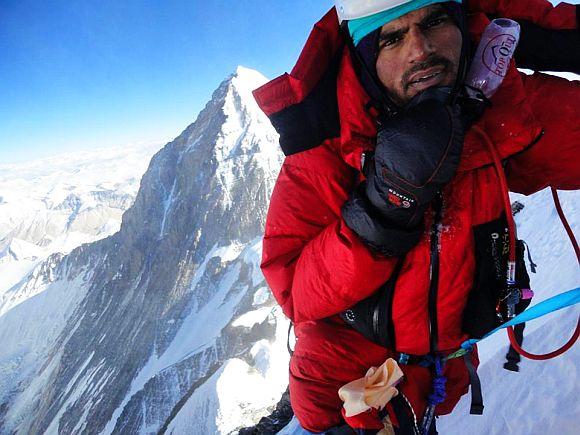
To mark the 60th anniversary of the conquest of Mt Everest, Pune's Giripremi led simultaneous climbs on the world's tallest peak as well as the Mt Lhotse, the world's fourth tallest. Ashish Mane, who climbed Lhotse as part of the expedition and who scaled Everest last year, speaks to Manu Shankar about the experience
Ideally a 22-year-old would be absorbed in studies, or would be contemplating a job that would provide a secure future.
But ask Pune's Ashish Mane and he would tell you that nothing beats the thrill of conquering the Himalayas and standing on top of the world.
When Mane conquered Mt Everest on May 19, 2012, he became the second youngest and first person from Maharashtra to do so (first being Arjun Vajpayee).
But Mane was not satisfied by just climbing the Mt Everest.
Two week later he started his preparations for another summit climb -- this time the 8,516 metre-tall Mt Lhotse.
Mane was a part of Pune's Giripremi Mountaineering, which had set out for the first civilian expedition from India attempting to scale two peaks, Mount Lhotse and Mount Everest, both above 8,000 metres, simultaneously. "This our gesture to celebrate 60 years of Edmund Hillary and Tenzing Norgay scaling the peak," Giripremi's Umesh Zirpe told Onkar singh. Zirpe, who led the expedition to Everest, said Mane's successful climb of Mt Lhotse came as a tremendous morale-booster to his team members.
Please ...

Everest is becoming a little commercial these days. Everyone wants to climb the highest peak," says Mane.
"I agree it's like the supreme challenge for any mountaineer to conquer Everest, but I wanted to scale more technical peaks," adds the Satara-based climber, who conquered Mt Lhotse on May 16.
"You see, these days there are so many facilities while climbing Everest. If you face any problems, Sherpas help you to come down as they are more experienced on such terrain. But having said that I really enjoyed climbing Mt Everest. The thrill was unimaginable," he adds.
Mt Lhotse, located on the border between Tibet and the Khumbu region of Nepal, is the fourth highest peak on earth after Mount Everest (8,848 m), K2 (8,611 m) and Kanchenjunga (8,586 m). It is connected to Everest via the South Col.
"Mountains are a tough place to be. I started off my preparations in Maharashtra by climbing rock walls that are at some heights.
"Before going to Lhotse I went to Nehru Institute of Mountaineering in Uttarkashi, where I did advanced training, which helped me immensely in gaining technical knowledge," the MSc (computer science) student says.
The team, which left Pune on March 21, halted in Kathmandu after which they started their trek in the last week of March.
The team reached the base camp of Everest on April 2, after traversing through an up and down altitude graph that ranged from 5,000 ft to 18,000 ft.
Please ...

On May 12 the team started their summit attempt from the Everest base camp. Crossing the tough terrain of Khumbu icefall, Camp 1, Western Cwm, Camp 2, Lhotse Face and Camp 3, the team, after three days, reached summit camps of Mt Lhotse and Mt Everest on May 15.
It was here that Mane broke from the group for his upward climb to Mt Lhotse. He started his climb at 2:30 am on May 16 in adverse weather conditions.
"It was very windy that day. Temperatures were ranging from minus 40 to minus 60 degrees, so keeping warm was a big challenge," he explains.
Going into terrain where the oxygen levels are limited, coupled with sub-zero temperatures, Ashish, who was accompanied by sherpas Lakpa Dirji and Pasang Sherpa, was armed with three oxygen cylinders along with processed food for the journey.
"During the climb we used to take 15-20 minutes break, wherein we would change the cylinders if needed and leave it there and take back on the downhill journey," says Mane.
"I was trained to carry 30 kg on my back to get used to the weight," he says.
"Then again the during the Lhotse climb, there was no rope in the final 50-80 metres. I managed to climb with the rope that was left behind by previous climbers, which is ideally inadvisable," he adds.
So how difficult was to convince his parents before the climb?
"To be honest I didn't tell them about my Everest climb. Because I wasn't confident of telling them. So I kept it to myself," he laughs.
"It was only when the news reports came in that they got to know and came to Pune and met our leader Umesh Zirpe and he showed the photographs and videos of our expedition. They were proud of my achievement."
"Then again when I told them about the Lhotse climb, they were a bit skeptical and they said 'you have climbed Everest, why Lhotse now, which is so difficult'. But I stood firm and they finally gave in," he adds.
...